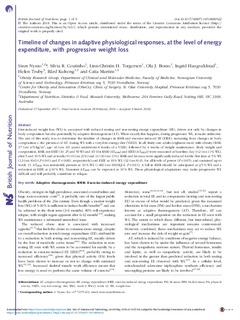| dc.contributor.author | Nymo, Siren | |
| dc.contributor.author | Coutinho, Silvia dos Santos Ribeiro F | |
| dc.contributor.author | Torgersen, Linn-Christin H. | |
| dc.contributor.author | Bomo, Ola Jakob | |
| dc.contributor.author | Haugvaldstad, Ingrid | |
| dc.contributor.author | Truby, Helen | |
| dc.contributor.author | Kulseng, Bård Eirik | |
| dc.contributor.author | Martins, Catia | |
| dc.date.accessioned | 2019-02-19T15:04:29Z | |
| dc.date.available | 2019-02-19T15:04:29Z | |
| dc.date.created | 2018-10-01T13:49:04Z | |
| dc.date.issued | 2018 | |
| dc.identifier.citation | British Journal of Nutrition. 2018, 120 (2), 141-149. | nb_NO |
| dc.identifier.issn | 0007-1145 | |
| dc.identifier.uri | http://hdl.handle.net/11250/2586366 | |
| dc.description.abstract | Diet-induced weight loss (WL) is associated with reduced resting and non-resting energy expenditure (EE), driven not only by changes in body composition but also potentially by adaptive thermogenesis (AT). When exactly this happens, during progressive WL, remains unknown. The aim of this study was to determine the timeline of changes in RMR and exercise-induced EE (EIEE), stemming from changes in body composition v. the presence of AT, during WL with a very-low-energy diet (VLED). In all, thirty-one adults (eighteen men) with obesity (BMI: 37 (sem 4·5) kg/m2; age: 43 (sem 10) years) underwent 8 weeks of a VLED, followed by 4 weeks of weight maintenance. Body weight and composition, RMR, net EIEE (10, 25 and 50 W) and AT (for RMR (ATRMR) and EIEE (ATEIEE)) were measured at baseline, day 3 (2 (sem 1) % WL), after 5 and 10 % WL and at weeks 9 (16 (sem 2) %) and 13 (16 (sem 1) %). RMR and fat mass were significantly reduced for the first time at 5 % WL (12 (sem 8) d) (P<0·01 and P<0·001, respectively) and EIEE at 10 % WL (32 (sem 8) d), for all levels of power (P<0·05), and sustained up to week 13. ATRMR was transiently present at 10 % WL (−460 (sem 690) kJ/d, P<0·01). A fall in RMR should be anticipated at ≥5 % WL and a reduction in EIEE at ≥10 % WL. Transient ATRMR can be expected at 10 % WL. These physiological adaptations may make progressive WL difficult and will probably contribute to relapse. | nb_NO |
| dc.language.iso | eng | nb_NO |
| dc.publisher | Nutrition Society | nb_NO |
| dc.rights | Navngivelse 4.0 Internasjonal | * |
| dc.rights.uri | http://creativecommons.org/licenses/by/4.0/deed.no | * |
| dc.title | Timeline of changes in adaptive physiological responses, at the level of energy expenditure, with progressive weight loss | nb_NO |
| dc.type | Journal article | nb_NO |
| dc.type | Peer reviewed | nb_NO |
| dc.description.version | publishedVersion | nb_NO |
| dc.source.pagenumber | 141-149 | nb_NO |
| dc.source.volume | 120 | nb_NO |
| dc.source.journal | British Journal of Nutrition | nb_NO |
| dc.source.issue | 2 | nb_NO |
| dc.identifier.doi | 10.1017/S0007114518000922 | |
| dc.identifier.cristin | 1616776 | |
| dc.description.localcode | This is an Open Access article, distributed under the terms of the Creative Commons Attribution licence (http://creativecommons.org/licenses/by/4.0/), which permits unrestricted reuse, distribution, and reproduction in any medium, provided the original work is properly cited. | nb_NO |
| cristin.unitcode | 194,65,15,0 | |
| cristin.unitcode | 194,65,0,0 | |
| cristin.unitname | Institutt for klinisk og molekylær medisin | |
| cristin.unitname | Fakultet for medisin og helsevitenskap | |
| cristin.ispublished | true | |
| cristin.fulltext | original | |
| cristin.qualitycode | 1 | |

